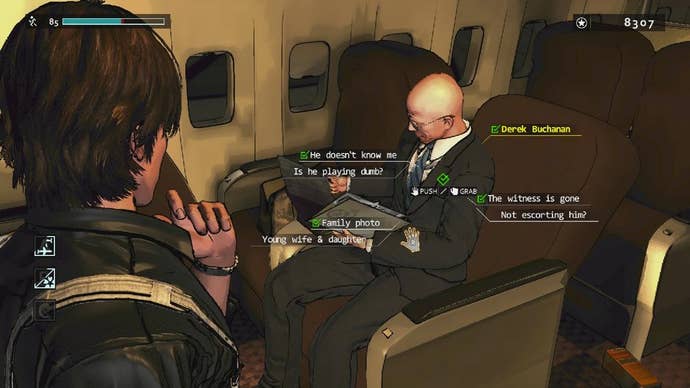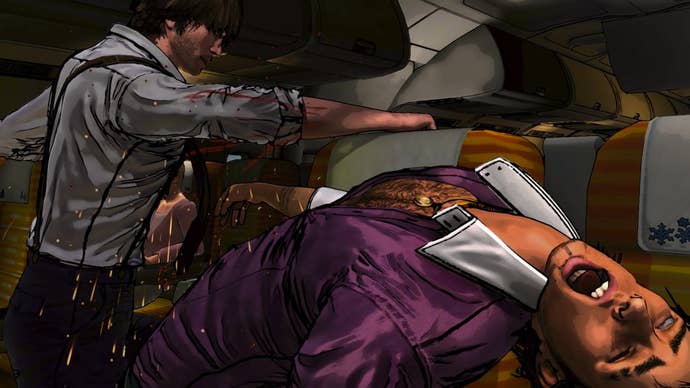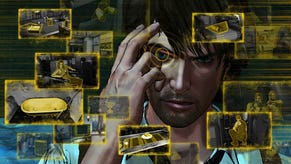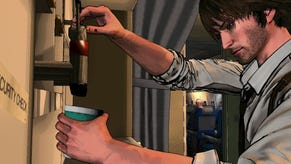D4: Dark Dreams Don't Die Xbox One Review: Murder by Letters
Deadly Premonition's SWERY returns with another off-kilter detective story—and finally, a budget that lets his unique personality shine.
This article first appeared on USgamer, a partner publication of VG247. Some content, such as this article, has been migrated to VG247 for posterity after USgamer's closure - but it has not been edited or further vetted by the VG247 team.
2010's Deadly Premonition stands as one of the last console generation's greatest surprises—Director Hidetaka Suehiro's (otherwise known as SWERY) strange homage to Twin Peaks sprung unexpectedly from nowhere, and left those with an open mind absolutely transfixed. Many of us (me included) picked up the game for its supposed "so bad it's good" reputation, but we didn't expect to find genuinely lovable characters or a gripping murder mystery within its technically incompetent exterior.
If you're a fan of SWERY, you'll be happy to know the four years since Deadly Premonition's release haven't dulled his unique sensibilities one bit. And D4: Dark Dreams Don't Die certainly carries his hallmarks: oddball characters with bizarre idiosyncrasies, pop culture-laden conversations, an obsession with food and the alphabet, and a general focus on specificity—of people, places, and things—typically absent from your average video game experience. This time, though, thanks to D4's Xbox One exclusivity, his strange ideas finally have enough of a budget to come to life convincingly (relatively speaking, of course).

Like Deadly Premonition, D4 centers around a weirdo crime-solver, though it takes a much more manageable form than its predecessor: Instead of being a high-concept mashup of Grand Theft Auto and Majora's Mask, D4 feels very much like a modern Telltale adventure, though injected with a bit more "gameyness." In fact, even if you play it with Kinect, D4 controls like a classic point-and-click PC game. Nearly every action involves using a cursor to select on-screen items, and the main character can't be steered around directly—instead, you select different nodes around an environment, and the area surrounding each respective node acts as a "scene" in which he can interact with different things. Really, using the Kinect only complicates simple movements that can otherwise be performed with a single button press—which is kinda the Kinect's M.O., isn't it?
The story of D4 involves protagonist David Young, a detective with a taste for tequila and bubble gum (yes) whose life now revolves around his dead wife and her final words about a mysterious person known only as "D." Though Young quit the force, he now assists the police on a private basis, so long as the case at hand has links (even extremely tenuous ones) to his wife's murder. But David isn't working with deductive reasoning alone: By touching evidence from a crime scene, Young can transport himself back in time (via his bathroom) to just before the incident in question, and find answers to formerly unsolved mysteries.
The actual investigations play out much like those in Phoenix Wright: D4 sends you to locations packed with details, and tasks you with sussing through them to determine what's relevant to the case at hand. And while D4's environments might be small, they're absolutely packed with stuff—the prologue asks you to explore David's apartment, and I think I spent a good hour opening cabinets, sifting through shelves, and exploring the contents of his refrigerator before moving on to more plot-related matters. Though you're free to click away to your heart's content, interacting with items consumes David's stamina, which can only be recovered by consuming one of the many food items—including Deadly Premonition's famous turkey sandwich—located throughout. Or, if Young's really hankering for a meal, he can always return to his apartment, where his former boss, Forrest Kaysen (another SWERY tradition), will be more than willing to provide an excess of food and conversation.
To be fair, there's not much of a game here, but D4 goes to great lengths to keep the player involved. And if exploring mindlessly isn't your thing, using David's "Vision" ability zeroes in on the next object or character you need to interact with to continue the story. Really, the most "gamey" elements of D4 can be found in its rare combat scenes, which take the expected QTE route (something Telltale relies on as well), though the sheer inventiveness of these battles—featuring the same focus on props, comedy, and choreography as classic Jackie Chan movies—makes up for their extremely basic input. In all honesty, some of the fights entertained me so much, I wanted to watch them play out without distracting QTE prompts overlaid on top—like a one-on-one battle within a crowded airplane in which drink carts, luggage, and tray tables are used as highly effective weaponry.

Though D4 strikes a different chord than Deadly Premonition, it features the same voyeuristic quality that made the latter so appealing. Just as I spied around Deadly Premonition's town of Greenvale, peeping in windows and following characters as they went through their daily schedules, the most fun in D4 can be found in exploring every nook and cranny of its environments. And the game rewards players looking to mine it for every last drop of content: Most interactions yield credits, which can be exchanged for new outfits (for David and many other characters), songs from the soundtrack, and items to better his relationship with Amanda, his in-house feral cat girl (yes) who acts as a makeshift shop. And D4's handful of characters each offer their own side quests, which will have you answering quizzes about air travel regulations, playing mini games, and sitting through highly entertaining conversations about their various quirks. Simply put, the world D4 presents is one you'll be reluctant to leave behind.
The one real downside? As it stands, D4 can't be called a complete experience. Though it offers a pretty substantive ride for its price, this is only the game's first episode. And D4's "surprise" launch, lack of visibility in the Xbox One store, and general absence of info about the next installment have me worried Microsoft wants to wash their hands of SWERY and his unique vision. But, if you're okay without seeing a real resolution, D4 offers an experience you're not likely to find outside of the director's past work. The Xbox One might not be the most appropriate venue for D4, but if you happen to have one in your home, consider adding some SWERY to your life. You'll be glad you did.
VisualsThough some of the animations may be awkward, D4 looks fantastic, and offers plenty of cel-shaded environments absolutely <em>packed</em> with detail.
SoundD4's eclectic soundtrack serves the weirdness well, and the spirited voice acting (which includes some strong New England accents) does justice to the quirky script.
InterfaceThough it's designed for Kinect, D4 plays perfectly fine—and some would say better—with a controller. Some of the menus, though, feel strangely stubborn.
Lasting AppealIt may only last six hours, but D4 offers a lot of content to comb through. You're definitely not going to find everything on your first go.
ConclusionOnce again, SWERY injects a detective story with his patented brand of weirdness, though this time he's finally free of the technical limitations that hampered his past work. D4 isn't a flawless experience, but, as with Deadly Premonition, it offers a world and set of characters you won't want to leave behind.







